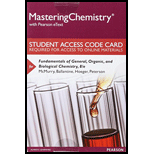
Concept explainers
(a)
Interpretation:
The direction of polarity of molecule
Concept Introduction:
Covalent bonds are formed by sharing of electrons between atoms.
The polarity of a bond is arises due to the difference in electronegativity of atoms present in that bonding.
The direction of polarity is represented by the vectors drawn towards the direction of more electronegative atom in a bonding.
(b)
Interpretation:
The direction of polarity of molecule
Concept Introduction:
Covalent bonds are formed by sharing of electrons between atoms.
The polarity of a bond is arises due to the difference in electronegativity of atoms present in that bonding.
The direction of polarity is represented by the vectors drawn towards the direction of more electronegative atom in a bonding.
(c)
Interpretation:
The direction of polarity of molecule
Concept Introduction:
Covalent bonds are formed by sharing of electrons between atoms.
The polarity of a bond is arises due to the difference in electronegativity of atoms present in that bonding.
The direction of polarity is represented by the vectors drawn towards the direction of more electronegative atom in a bonding.
(d)
Interpretation:
The direction of polarity of molecule
Concept Introduction:
Covalent bonds are formed by sharing of electrons between atoms.
The polarity of a bond is arises due to the difference in electronegativity of atoms present in that bonding.
The direction of polarity is represented by the vectors drawn towards the direction of more electronegative atom in a bonding.
Want to see the full answer?
Check out a sample textbook solution
Chapter 4 Solutions
Mastering Chemistry with Pearson eText -- Standalone Access Card -- for Fundamentals of General, Organic, and Biological Chemistry (8th Edition)
- Why is it not possible to find a five-fold symmetry operation in naturally-occurring crystals?arrow_forwardConsider the following acids and their ionization constant, determine which conjugate base is HCOOH Ka = 1.7 x 10-4 (b) HCN Ka = 4.9 x 10-10arrow_forwardIf one compound has the formula C5H10 and another has the formula C4H10, are the two compounds isomers? Explain.arrow_forward
- On the indicated blue bonds, which ones are able to rotate?arrow_forwardWrite the chemical formula for the conjugate base of each of the following acids: Carbonic Acid (H2CO3)___________________ Formic Acid (CH2O2)_____________________arrow_forwardIf water were not polar, would it dissolve sodium chloride? Explain.arrow_forward
- Given the balanced equation with an unknown compound represented by X, which compound is represented by X?arrow_forwardWrite the chemical formula of the conjugate base of boric acid.arrow_forwardDraw the structure of the tripeptide alanylglycylvaline and determine its name using three-letter abbreviations.arrow_forward
 BiochemistryBiochemistryISBN:9781319114671Author:Lubert Stryer, Jeremy M. Berg, John L. Tymoczko, Gregory J. Gatto Jr.Publisher:W. H. Freeman
BiochemistryBiochemistryISBN:9781319114671Author:Lubert Stryer, Jeremy M. Berg, John L. Tymoczko, Gregory J. Gatto Jr.Publisher:W. H. Freeman Lehninger Principles of BiochemistryBiochemistryISBN:9781464126116Author:David L. Nelson, Michael M. CoxPublisher:W. H. Freeman
Lehninger Principles of BiochemistryBiochemistryISBN:9781464126116Author:David L. Nelson, Michael M. CoxPublisher:W. H. Freeman Fundamentals of Biochemistry: Life at the Molecul...BiochemistryISBN:9781118918401Author:Donald Voet, Judith G. Voet, Charlotte W. PrattPublisher:WILEY
Fundamentals of Biochemistry: Life at the Molecul...BiochemistryISBN:9781118918401Author:Donald Voet, Judith G. Voet, Charlotte W. PrattPublisher:WILEY BiochemistryBiochemistryISBN:9781305961135Author:Mary K. Campbell, Shawn O. Farrell, Owen M. McDougalPublisher:Cengage Learning
BiochemistryBiochemistryISBN:9781305961135Author:Mary K. Campbell, Shawn O. Farrell, Owen M. McDougalPublisher:Cengage Learning BiochemistryBiochemistryISBN:9781305577206Author:Reginald H. Garrett, Charles M. GrishamPublisher:Cengage Learning
BiochemistryBiochemistryISBN:9781305577206Author:Reginald H. Garrett, Charles M. GrishamPublisher:Cengage Learning Fundamentals of General, Organic, and Biological ...BiochemistryISBN:9780134015187Author:John E. McMurry, David S. Ballantine, Carl A. Hoeger, Virginia E. PetersonPublisher:PEARSON
Fundamentals of General, Organic, and Biological ...BiochemistryISBN:9780134015187Author:John E. McMurry, David S. Ballantine, Carl A. Hoeger, Virginia E. PetersonPublisher:PEARSON





